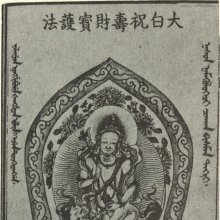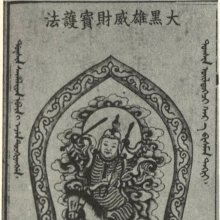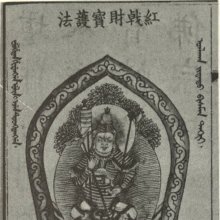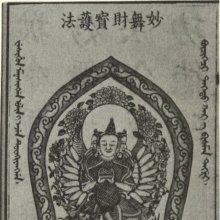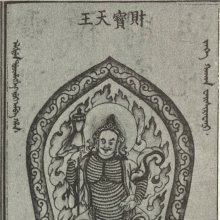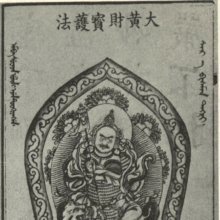Vaishravana, Vaiśravaṇa: 24 definitions
Introduction:
Vaishravana means something in Buddhism, Pali, Hinduism, Sanskrit, Jainism, Prakrit, the history of ancient India. If you want to know the exact meaning, history, etymology or English translation of this term then check out the descriptions on this page. Add your comment or reference to a book if you want to contribute to this summary article.
The Sanskrit term Vaiśravaṇa can be transliterated into English as Vaisravana or Vaishravana, using the IAST transliteration scheme (?).
Images (photo gallery)
(+2 more images available)
In Hinduism
Purana and Itihasa (epic history)
Source: archive.org: Puranic EncyclopediaVaiśravaṇa (वैश्रवण).—Kubera. (See under Kubera).
Source: archive.org: Shiva Purana - English TranslationVaiśravaṇa (वैश्रवण) is the son of Viśravas and became Kubera in the Pādmakalpa, as mentioned in the Śivapurāṇa 2.1.19.—“[...] in the Kalpa called Pādma, I created my mental son Pulastya whose son Viśravas begot the son Vaiśravaṇa. He propitiated the three-eyed God Śiva, with a very severe penance and enjoyed the city of Alakā built by Viśvakṛt. When that Kalpa was over and the Meghavāhana Kalpa had started, the son of Yajñadatta, Śrīda, performed a severe penance”.
Source: Cologne Digital Sanskrit Dictionaries: The Purana Index1a) Vaiśravaṇa (वैश्रवण).—A Ṛṣika and a king who became sage by satya.*
- * Brahmāṇḍa-purāṇa II. 32. 102; Matsya-purāṇa 145. 96; Vāyu-purāṇa 59. 94.
1b) Served as calf when the Yakṣas milked the earth;1 overlord of the Yakṣas and the Rākṣasas; the first son of Viśravas and Davavarṇinī; seeing the Rākṣasa form and asura prowess he got the name Kubera;2 defeated by Kālanemi.3
- 1) Brahmāṇḍa-purāṇa II. 36. 216; Matsya-purāṇa 10. 22.
- 2) Brahmāṇḍa-purāṇa III. 8. 7, 40-46; Matsya-purāṇa 8. 3; 154. 338.
- 3) Ib. 174. 49; 177. 49.
1c) Is Rāvaṇa.*
- * Brahmāṇḍa-purāṇa III. 71. 160.
1d) (Kubera: Kuśarīram beram); the first son of Viśravas and Devavarṇinī; in form a Rākṣasa and in strength an Asura; description of; three feet, big head, eight teeth, yellow moustache, ears like śanku, short hands; full of the knowledge of Vaivarta; and in the guise of Viśvarūpa or various forms;1 the king of Yakṣas.2

The Purana (पुराण, purāṇas) refers to Sanskrit literature preserving ancient India’s vast cultural history, including historical legends, religious ceremonies, various arts and sciences. The eighteen mahapuranas total over 400,000 shlokas (metrical couplets) and date to at least several centuries BCE.
Dharmashastra (religious law)
Source: archive.org: The religion and philosophy of the Veda and the Upanishads (dharmashastra)Vaiśravaṇa (वैश्रवण) is the name of a deity to be invoked in a certain ritual, according to the Mānavagṛhyasūtra 2.14. Accordingly, the deity is prescribed when one suffers from possession by the Vināyakas, Śālakaṭaṅkaṭa, Kūṣmāṇḍarājaputra, Usmita and Devayajana. The Baijavāpagṛhyasūtra replaces the names of last two vināyakas with Mita and Sammita. According to R. C. Hazra in his Gaṇapati-worship, “this rite is both expiatory and propitiatory in nature and in which various things including meat and fish (both raw and cooked) and wine and cakes are to be offered”..
The gṛhya-sūtras are a branch of dharma-sūtras and refer to a category of Vedic literature dealing with domstic rites and rituals. The Mānava-gṛhya-sūtra belongs to the Kṛṣṇa-yajurveda. The Baijavāpa-gṛhya-sūtra is known only through references to it in other works (e.g., Vīramitrodaya-Saṃskāra).

Dharmashastra (धर्मशास्त्र, dharmaśāstra) contains the instructions (shastra) regarding religious conduct of livelihood (dharma), ceremonies, jurisprudence (study of law) and more. It is categorized as smriti, an important and authoritative selection of books dealing with the Hindu lifestyle.
In Buddhism
Tibetan Buddhism (Vajrayana or tantric Buddhism)
Source: Google Books: VajrayoginiVaiśravaṇa (वैश्रवण) is another name for Kubera: protector deity of the northern cremation ground.—Synonyms for Kubera are Dhanada (Saṃvarodayatantra 17.39), Yakṣādhipa (Guhyasamayasādhanamālā 34) or Vaiśravaṇa (Gyatso). Kubera is the custodian of wealth, and king of the yakṣas. Iconographically in the Śmaśānavidhi, Kubera has a human mount (naravāhana), is yellow, and holds a “mongoose spitting out a jewel” and skull bowl. In the Adbhutaśmaśānālaṃkāra he is yellow, mounted on a nidhi and holds a club (left) and makes the gesture of threatening (right).
Source: archive.org: The Indian Buddhist IconographyVaiśravaṇa (वैश्रवण) refers to eight Yakṣa kings, commonly depicted in Buddhist Iconography, and mentioned in the 11th-century Niṣpannayogāvalī of Mahāpaṇḍita Abhayākara.—The Yakṣas are a semi-mythical class of beings who are supposed to preside over treasures and shower wealth on mankind when propitiated. They are all collectively described in the dharmadhātuvāgīśvara-maṇḍala in one brief sentence:—“The Yakṣa kings [viz., Vaiśravaṇa] hold in their hands the bījapūra (citron) and the nakula (mongoose) in the right and left hands respectively”.—Vaiśravaṇa is yellow in colour.
Source: OSU Press: Cakrasamvara SamadhiVaiśravaṇa (वैश्रवण) is the name of a deity [i.e., oṃ vaiśravaṇāya svāhā], according to the Kalaśa Pūjā [i.e., Kalasha Worship] ritual often performed in combination with the Cakrasaṃvara Samādhi, which refers to the primary pūjā and sādhanā practice of Newah Mahāyāna-Vajrayāna Buddhists in Nepal.

Tibetan Buddhism includes schools such as Nyingma, Kadampa, Kagyu and Gelug. Their primary canon of literature is divided in two broad categories: The Kangyur, which consists of Buddha’s words, and the Tengyur, which includes commentaries from various sources. Esotericism and tantra techniques (vajrayāna) are collected indepently.
Mahayana (major branch of Buddhism)
Source: archive.org: Bulletin of the French School of the Far East (volume 5)Vaiśravaṇa (वैश्रवण) is the name of a king appointed as one of the Divine protector deities of Khotan, according to chapter 17 of the Candragarbha: the 55th section of the Mahāsaṃnipāta-sūtra, a large compilation of Sūtras (texts) in Mahāyāna Buddhism partly available in Sanskrit, Tibetan and Chinese.—In the Candragarbhasūtra, the Bhagavat invites all classes of Gods and Deities to protect the Law [dharma?] and the faithful in their respective kingdoms of Jambudvīpa [e.g., the king Vaiśravaṇa in Khotan (Yu-t'ien; =Kustana or Kusthana ?)], resembling the time of the past Buddhas.
Source: Brill: Śaivism and the Tantric Traditions (mahayana)Vaiśravaṇa (वैश्रवण) refers to one of the “four great kings” (Caturmahārāja), according to the sixth chapter of the Suvarṇaprabhāsottamasūtra, which teaches the protection of the state for the mutual benefit of the Buddhist Sangha and the monarch.—Accordingly, the Caturmahārājaparivarta or Chapter on the Four Great Kings, conveys an explicit message: those kings (manuṣyarāja) who venerate the Suvarṇaprabhāsottama and support the Buddhist Sangha will be protected from hostile armies and other dangers by the Four Great Kings (caturmahārāja), and their countries will exist in highest state of harmony. Simultaneously, those who ignore this tradition will face decline. These eminent Yakṣas [i.e., Vaiśravaṇa] are celestial guardians of the cardinal directions, along with their retinues in Jambudvīpa.
Source: De Gruyter: A Buddhist Ritual Manual on AgricultureVaiśravaṇa (वैश्रवण) refers to the “lord of wealth” (i.e., one of the four great kings—comparable to Kubera), according to the Vajratuṇḍasamayakalparāja, an ancient Buddhist ritual manual on agriculture from the 5th-century (or earlier), containing various instructions for the Sangha to provide agriculture-related services to laypeople including rain-making, weather control and crop protection.—Accordingly, “Then the Bhagavān went to the residence of Vaiśravaṇa, the Great King, with a great retinue, a great assembly-gathering, a great host, an indication of great supernatural power, displaying great miracles”.

Mahayana (महायान, mahāyāna) is a major branch of Buddhism focusing on the path of a Bodhisattva (spiritual aspirants/ enlightened beings). Extant literature is vast and primarely composed in the Sanskrit language. There are many sūtras of which some of the earliest are the various Prajñāpāramitā sūtras.
In Jainism
General definition (in Jainism)
Source: archive.org: The Jaina IconographyVaiśravaṇa (वैश्रवण) or Kuvera, the king of the Yakṣas, who was the treasurer of Śiva and lord of the Alakā is several times referred to in early Hindu literature. His attendants were many and several of them are mentioned in a canonical text of the Jainas thus, Pūrṇabhadra, Maṇibhadra, Śālibhadra, Sumanabhadra, Lakṣarakṣa, Pūrṇarakṣa, Śravaṇa, Sarvayaśas, Sarvakāma, Samṛddha, Amogha, Asmata.
Source: archive.org: TrisastisalakapurusacaritraVaiśravaṇa (वैश्रवण) is the name of one of the various childhood friends of Mahābala (son of king Bala from Vītaśoka), according to chapter 6.6 [śrī-mallinātha-caritra] of Hemacandra’s 11th century Triṣaṣṭiśalākāpuruṣacaritra: an ancient Sanskrit epic poem narrating the history and legends of sixty-three illustrious persons in Jainism.
Accordingly:—“[...] A son, named Mahābala, having complete power, indicated by the dream of a lion, was borne to the king [i.e., Bala] by his wife Dhāriṇī. When he was grown, Mahābala married on one day five hundred princesses, Kamalaśrī and others. He had childhood-friends, Acala, Dharaṇa, Pūraṇa, Vasu, Vaiśravaṇa, and Abhicandra. [...]”.
2) Vaiśravaṇa (वैश्रवण) refers to one of the ancient rulers of Laṅkā, according to the Jain Ramayana and chapter 7.2 [Rāvaṇa’s expedition of conquest].—Accordingly, “After they had heard of the hostility between their fathers, Kumbhakarṇa and Bibhīṣaṇa were always attacking Laṅkā ruled over by Vaiśravaṇa. Then Vaiśravaṇa sent word to Sumālin by a messenger, ‘Control your own sons, look you! these younger brothers of Rāvaṇa. They, insolent, thinking themselves heroes, do not know the (comparative) strength of themselves and others. [...]’”.

Jainism is an Indian religion of Dharma whose doctrine revolves around harmlessness (ahimsa) towards every living being. The two major branches (Digambara and Svetambara) of Jainism stimulate self-control (or, shramana, ‘self-reliance’) and spiritual development through a path of peace for the soul to progess to the ultimate goal.
India history and geography
Source: archive.org: Nilamata Purana: a cultural and literary study (history)Vaiśravaṇa (वैश्रवण) corresponds to modern Vastarvan as mentioned in the Nīlamatapurāṇa.
Source: academia.edu: The Chronological History of Ancient Sri LankaValmiki Ramayana informs us that Ravana and Vaishravana were the sons of Vishravas and Kaikesi. Seemingly, Vaishravana became the king of Sri Lanka and Ravana inherited the kingdom of his father in South India. The golden city of Lankapuri was designed and built by Vishvakarma. Lankapuri was the most beautiful city of the world during Ramayana era. Ravana forcibly took over the city of Lankapuri and Pushpaka Vimana from his brother Vaishravana also known as Kubera. Thus, Ravana became the emperor of a vast kingdom extended from Sri Lanka to Dandakaranya of South India. Vaishravana had no other option to emigrate northwards along with Yakshas and settled at Alakapuri situated on the ancient silk route close to Uttara Kuru region.

The history of India traces the identification of countries, villages, towns and other regions of India, as well as mythology, zoology, royal dynasties, rulers, tribes, local festivities and traditions and regional languages. Ancient India enjoyed religious freedom and encourages the path of Dharma, a concept common to Buddhism, Hinduism, and Jainism.
Languages of India and abroad
Sanskrit dictionary
Source: DDSA: The practical Sanskrit-English dictionaryVaiśravaṇa (वैश्रवण).—
1) Name of Kubera, the god of wealth; विभाति यस्यां ललितालकायां मनोहरा वैश्रवणस्य लक्ष्मीः (vibhāti yasyāṃ lalitālakāyāṃ manoharā vaiśravaṇasya lakṣmīḥ) Bv.2.1; यदाश्रोषं वैश्रवणेन सार्धम् (yadāśroṣaṃ vaiśravaṇena sārdham) Mahābhārata (Bombay) 1.1.166.
2) Name of Rāvaṇa.
Derivable forms: vaiśravaṇaḥ (वैश्रवणः).
Source: Cologne Digital Sanskrit Dictionaries: Edgerton Buddhist Hybrid Sanskrit DictionaryVaiśravaṇa (वैश्रवण).—(in meaning 1 = Sanskrit id., Pali Vessavaṇa, and see prec.), (1) one of the four mahārāja(n), q.v., guardian of the north and lord of yakṣas; (2) name of a nāga- king: Mahā-Māyūrī 247.19.
Source: Cologne Digital Sanskrit Dictionaries: Shabda-Sagara Sanskrit-English DictionaryVaiśravaṇa (वैश्रवण).—m.
(-ṇaḥ) 1. Kuvera, the god of wealth. 2. Ravana. E. viśravas their father, aff. aṇ, and the form irr.
Source: Cologne Digital Sanskrit Dictionaries: Benfey Sanskrit-English DictionaryVaiśravaṇa (वैश्रवण).—m. Kuvera, [Hitopadeśa] ii. [distich] 91.
Source: Cologne Digital Sanskrit Dictionaries: Cappeller Sanskrit-English DictionaryVaiśravaṇa (वैश्रवण).—[masculine] patron. of Kubera.
Source: Cologne Digital Sanskrit Dictionaries: Monier-Williams Sanskrit-English Dictionary1) Vaiśravaṇa (वैश्रवण):—m. ([from] vi-śravaṇa; cf. [gana] śivādi) a [patronymic] ([especially] of Kubera and Rāvaṇa), [Atharva-veda] etc. etc.
2) (in [astronomy]) Name of the 14th Muhūrta
3) mf(ī)n. relating or belonging to Kubera, [Mahābhārata]
Source: Cologne Digital Sanskrit Dictionaries: Yates Sanskrit-English DictionaryVaiśravaṇa (वैश्रवण):—(ṇaḥ) 1. m. Kuvera, god of wealth.
Source: DDSA: Paia-sadda-mahannavo; a comprehensive Prakrit Hindi dictionary (S)Vaiśravaṇa (वैश्रवण) in the Sanskrit language is related to the Prakrit words: Vaisavaṇa, Vesavaṇa.
[Sanskrit to German]
Sanskrit, also spelled संस्कृतम् (saṃskṛtam), is an ancient language of India commonly seen as the grandmother of the Indo-European language family (even English!). Closely allied with Prakrit and Pali, Sanskrit is more exhaustive in both grammar and terms and has the most extensive collection of literature in the world, greatly surpassing its sister-languages Greek and Latin.
Kannada-English dictionary
Source: Alar: Kannada-English corpusVaiśravaṇa (ವೈಶ್ರವಣ):—
1) [noun] (myth.) Kubēra, the Regent of Wealth.
2) [noun] Rāvaṇa, the villain character in the epic Rāmāyaṇa.
Kannada is a Dravidian language (as opposed to the Indo-European language family) mainly spoken in the southwestern region of India.
See also (Relevant definitions)
Starts with: Vaishravanacitra, Vaishravanakuta, Vaishravanalaya, Vaishravananuja, Vaishravanarajan, Vaishravanavas, Vaishravanavasa, Vaishravanodaya.
Ends with: Bahirvaishravana.
Full-text (+166): Gaviputra, Vaishramana, Vaishravanodaya, Vaishravanavasa, Vaishravanalaya, Kubera, Yakshadhipa, Vishravas, Go, Maharaja, Ekapinga, Vaisavana, Vesavana, Vaishravananuja, Pishacakin, Bahirvaishravana, Cudeshvara, Shata, Devavarni, Vaicciravanan.
Relevant text
Search found 53 books and stories containing Vaishravana, Vaiśravaṇa, Vaisravana; (plurals include: Vaishravanas, Vaiśravaṇas, Vaisravanas). You can also click to the full overview containing English textual excerpts. Below are direct links for the most relevant articles:
Mahabharata (English) (by Kisari Mohan Ganguli)
Section LXXIV < [Rajadharmanusasana Parva]
Section LXX < [Anugita Parva]
Section CCLXXII < [Draupadi-harana Parva]
The gods of northern Buddhism (by Alice Getty)
Puranic encyclopaedia (by Vettam Mani)
Trishashti Shalaka Purusha Caritra (by Helen M. Johnson)
Part 4: Rāvaṇa’s sons < [Chapter II - Rāvaṇa’s expedition of Conquest]
Part 11: Reincarnation of Vaiśravaṇa (fifth of Malli’s six former friends) < [Chapter VI - Śrī Mallināthacaritra]
Part 8: Story of Brāhman boy < [Chapter I - Five previous incarnations]
Ramayana of Valmiki (by Hari Prasad Shastri)
Chapter 3 - Vishravas becomes the Protector of Wealth < [Book 7 - Uttara-kanda]
Chapter 9 - The Birth of Dashagriva and his Brothers < [Book 7 - Uttara-kanda]
Chapter 26 - Nalakuvara curses Ravana < [Book 7 - Uttara-kanda]
Maha Prajnaparamita Sastra (by Gelongma Karma Migme Chödrön)
Appendix 13 - Notes on the stanzas spoken by Vaiśravaṇa in honor of the Buddha < [Chapter VIII - The Bodhisattvas]
Bodhisattva quality 26: concentration commemorating the Buddhas < [Chapter XIII - The Buddha-fields]
Appendix 4 - Buddha’s subjugation of the elephant Nālāgiri (or Dhanapāla) < [Chapter XLII - The Great Loving-kindness and the Great Compassion of the Buddhas]
Related products
